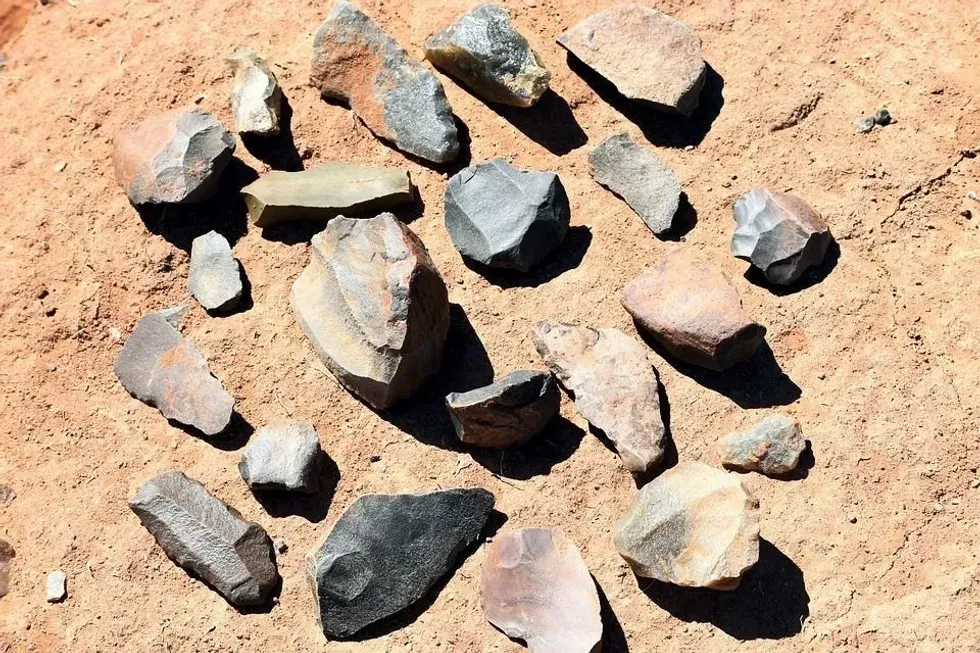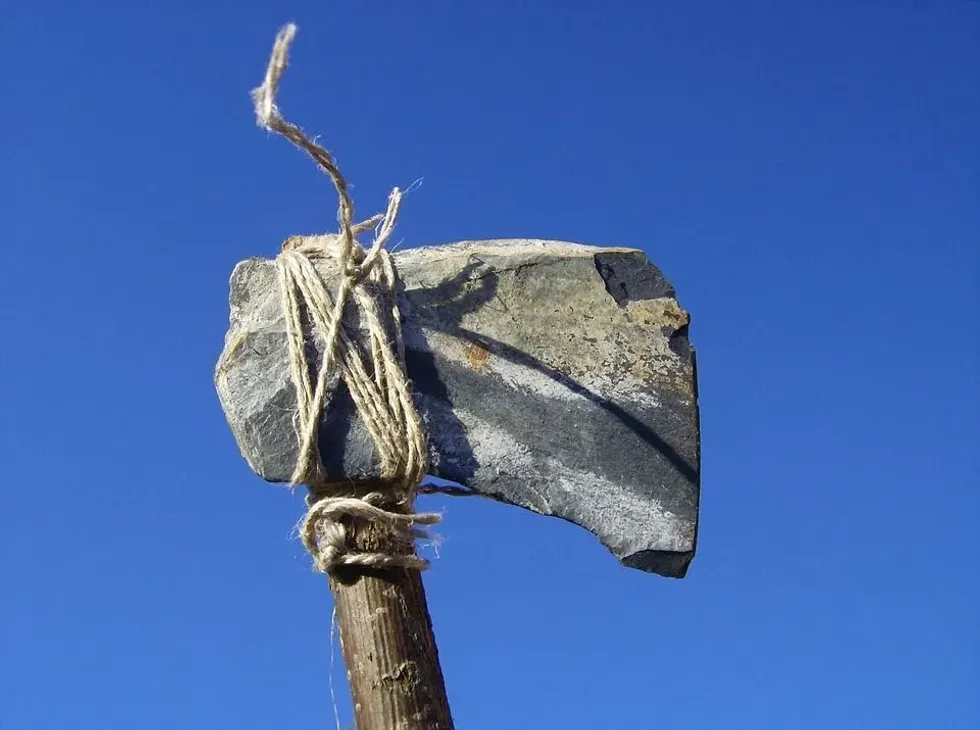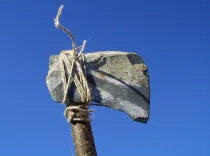99+ Facts About Stone Age Inventions In The Palaeolithic Period

Historically the stone age is a period of human development, a cultural stage characterized by the creation and use of stone tools.
The Paleolithic age period lasted for roughly 3.4 million years and ended between 5,000 BCE until the last ice age. This period began with the implementation of stones and ended with the first use of bronze.
The Paleolithic age is the first era of human history, which lasted from the beginnings of humanity through the ice age. People of the Paleolithic age did not have a political organization, and communities were divided into nomadic or semi-nomadic tribes. In Greek, paleo means old, and lithic means stone.
Paleolithic, Mesolithic, and Neolithic- the stone age is divided into three periods based on tools. The other name for the paleolithic period is the old stone age, and it is the prehistoric times when the stone tools were used to break things, cut, and smash.
The Mesolithic period is called the middle stone age, and the Mesolithic period is between the Paleolithic and Neolithic ages.
In this period, humans reduced moving from one place to another. Their main work was to engage in food gathering, hunting, fishing, and domesticating animals.
The Neolithic age is the new stone age, and the Neolithic period is the last part of the stone age.
Evidence suggests that development took place over a long period. Neolithic Revolution is mainly the use age of agriculture, development of human technology and cultural evolution, settlement in permanent villages, crafting of pottery, weaving, and competence in handling textile raw materials led to the invention of fabrics from animal skin.
If you are amazed at the facts about the stone age, you would definitely like our other articles on Paleolithic age inventions and the biggest invention ever here on Kidadl.
Timeline
As the earliest part of the stone age, humans used stones, wood, and bone to make tools and weapons for chopping. To cut or chip things quickly, they invented a sharp stone called 'Flint.'
The people from the stone age killed animals for food and clothing. The stone age ended after the people developed the making of metal. Then came the bronze age.
Embroidery appeared in the bronze age, where people used to decorate clothing, shoes, fashion bags to add a fashion look. Let's find out the other facts about inventions in the stone age.
The first Homo sapiens arrived in Britain in 700,000 BC and 40,000 years ago. The main concern of the stone age was shelter and food, and people migrated for food and shelter.
One of the facts was, there were no permanent settlements during the stone age. There are many other inventions and exciting facts about this era. Let's find out the other facts of the Palaeolithic period.
The Paleolithic age was divided into three periods based on technology, the Lower Paleolithic, the Middle Paleolithic, and the Upper Paleolithic.
The Lower Paleolithic was around 2.5 million years ago, or early as 3.3 million years ago. A simple tool, like a hand axe, was crafted. During this time, hominins discovered many new things for their survival.
The Middle Paleolithic was around 250,000-30,000 years ago, is defined by stone flake tools and more use of controlled fire.
The last one is the Upper Paleolithic, early humans produced increasingly specialized and sophisticated tools made of bone, ivory, stone, and antlers.
Humans first started using metals in the bronze age. The iron age was a period between 1200 B.C. and 600 B.C.
Climates during the Paleolithic age became drier, cooler, and seasonal. The period started from the Lower Paleolithic period and lasted until the last ice age, 10,000 years ago. Around 6,000 years ago, there was a rise in the sea levels, new food sources, and the necessity to adapt to a changing environment.
In the stone age, humans knew when to expect yearly floods and could plan the planting of crops, hunting, and if they could live on the river banks.
Types Of Inventions
The invention is nothing but the innovative ideas in our minds and is generated to solve small and large problems. In the ancient world, achieving anything was relatively easy.
Can you imagine the situation in the Paleolithic age when there were no media, no phones, no televisions, no gas to cook, no transportation?
Today we can enjoy modern innovations due to the million years of innovation and evolution from scratch. As there is a saying, necessity is the mother of all invention, whenever the people in the stone age found it difficult, they tried to invent something new.
Our ancestors used natural resources to invent new things like stone, wood, mud, etc. they discovered fire and art and made essential tools. Stone age tools were mainly made out of stone, giving the stone age its name. Let us look into some of the human inventions of the stone age.
Stone Tools: The first invention of humans was stone tools. Cutting, pounding, hunting, hacking were done with these tools.
Stone age people wore clothes made from animal hides with the help of stone scrapers. Hunting became easier with stone flakes, and cutting trees was easy with the stone axe. Prehistoric humans used hammerstones to chip other stones into sharp edges, and the stones were sharpened using a process called flaking.
Early humans also used wood, bone, fiber, and sinew to bind stones to handles. Cutting tools and scraping were done by flaking and polishing stones. Homo erectus (the very first humans) used stone tools.
Nomadic Hunter: The stone age peoples were nomadic; they did not settle in one place. So, they never felt the need to cultivate or raise livestock. They depended on nuts, fruits, plants, fish, and hunted.
Farming: By the end of the stone age, people stopped moving from place to place and started forming groups, communities, and small villages. Then they felt the need for cultivation. Hence, the invention of farming came into being. That led to writing, irrigation, job specialization, villages, governments, etc.
Banding Together: Paleolithic hominins moved and lived in groups, cared for their children, and supported elderly members.
Controlled Fire: Another invention of this age was the controlled fire—the archaeological evidence early humans used controlled fire even before the Paleolithic Era. At the beginning of the Neolithic Revolution, humans learned to make fire.
Fires remain an essential part of human life, and fire helps cook food, protect from wild animals, and keep the body warm in winter.
The fire was produced by the friction method. The earliest evidence found in South Africa and Kenya Terra, Chesowanja, Amata, Swartkrans, France, suggested that fire was discovered in the stone age about 1.5 million years ago.
Built Shelter: Humans used natural environments like trees and caves to shelter themselves and protect themselves from wild animals and weather before they knew how to build shelters. Later the humans built huts made of mud, wood and covered the roof with leaves or hay.
Towards the end of the stone age, they started building permanent houses with a roof.
Containers: The people of the Paleolithic age invented containers like baskets, and pottery, used to store food, grains, or liquids from spoiling, protect food from rodents.
Sewing: the process of stitching with the help of sewing needles and thread. Archaeologists believe that before spinning yarn or weaving fabric was invented, in the stone age, people across Europe and Asia sewed leather or fur clothes using bones, ivory needles, and thread made from various parts of animals. For many years sewing was done by hand.
Bow And Arrow: In Western Europe and North Africa, early use of bows were found in the cave paintings and arrows in Sibudu Cave in South Africa nearly 71,000 years ago. The stone age hunters used the bow and arrow to kill large animals, mammals, and birds.
Axe: Axe was invented around 1.6 million years ago. Hand-axe is the most common tool of the stone age and has a variety of shapes like triangular, circular, or teardrop shapes. These tools are used to cut wood or meat.
Hunting of Megafauna: In this Paleolithic period, humans hunted megafauna like mammoths. But due to overhunting or the climatic change, these animals started diminishing at the end of this era.
Evidence of Art and Music: There was evidence of art and musical instruments during this Paleolithic Era. Art can be found on rocks, painted caves, and even carved instruments from the bone.
Braided rope: Ancient Egypt was the first civilization to make rope. The rope was discovered in 17,000 B.C.E. Rope was found in southwest France and Lascaux caves.
Lunar Calendar: Calendar was also an important invention of the Stone age. Earlier evidence of the Lunar calendar was also found in southwest France and Lascaux caves.
Alcoholic Drinks: Alcohol was famous in all civilizations, primarily consumed in religious ceremonies and celebrations. It was a mixture of fruit and water.
Oil Lamp: Early stone age people made lamps out of seashells or stone, filled with animal fat and vegetable used as a wick. The first natural oil lamp was found around 10,000 B.C.E.
Sling: The oldest slings were found in Tutankhamen's tomb, dating more than 10,000 years. This sling is a blunt weapon, such as lead, clay, and stone.
Uses
It was discovered in early modern human culture, from sewing needles, axes to everything you need to know about prehistoric tools and art in this era. In the late 19th century, the term Paleolithic age or the stone age was found by Englishman John Lubbock. During this era, archeology became popular due to being increasingly professionalized and methodical.
This era lasted from 2.6 million years ago to about 12,000 years ago. Around 500,000 BP, a clan of early humans settled in Neanderthals. The Neanderthals began with hunting and knew how to bury dead bodies perfectly.
The Paleolithic period lasted for a long time, for over 99% of all human history. There were four types of humans; toolmakers, fire makers, neanderthals, and modern humans in the stone age.
The stone age era is remarkable of all the eras. This period was full of new inventions. The humans knew the usage of bow and arrows, building roads, and other transport modes like kayaks, shafts, and boats. This era's early humans were the first to write on caves and painting.

Amazing Facts About Stone Age Inventions
Human history proved that the stone age tools were 25,000-50,000 years old. The most common tools are spear points for hunting, hand axes, daggers, choppers for cutting up meat, and scrapers for cleaning animal hides. Cows, goats, sheep, etc., were domesticated.
The oldest evidence of arrows comes from the South African site of Sibudu Cave.
The oldest stone tools were dug out from Lomekwi 3 in West Turkana, and they were so old that a pre-human species could have invented them. The upper Paleolithic, about 40,000 years ago.
Art began to appear in parts of Europe, Africa, Asia, and the Near East. In the Lower Paleolithic (c. 840,000 – c. 800,000 BP), humans possibly invented rafts to travel in water.
The oldest stone tool used has been found around 3.4 million years old and can be evidenced in the fossilized animal bones with tool marks. The main task of Stone age humans was breaking the bones of the hunted animals, so they invented stone tools to cut or chop. The first needles were made of wood and bone.
Towards the end of the Paleolithic age, stone blades were early human inventions. Early humans used to use flint knives. During the stone age, some animals, such as the giant bear, cave bear, woolly mammoth, and woolly rhinoceros, were believed to be extinct. Dogs were domesticated in the stone age as they were believed to be wild animals.
During the Neolithic era, evidence proves that the houses in Skara Brae had cupboards, beds, chairs, and shelves. The Republic of Georgia was the first to evidence wine in the stone age. Grains are gathered using a u-shaped sickle.
The stone age people formed 20-50 people groups to help each other. People communicate via gestures and cries to express their joy, anger, fear, or danger alert.
In the stone age, jewelry pieces were made out of shells, bones, and tusks. The ancient known shoes were made with one piece of leather. It is believed that they were made around 5,500 years ago.
Europe was still attached to Africa in the initial stages of the stone age, which means that the distance between South Africa and London was much less. The Mesolithic period was significant as it shaped the island and continent due to climate change.
In the Paleolithic period, 28,000-25,000 years ago, the art forms of the stone age era are known as 'Venus figurines.' The first wooden spear invented was found in north Germany, and it is believed to be over 380,000-400,000 years old.
These Stone age inventions help early humans progress in the modern world with modern technologies that we are enjoying today. So we should always be thankful to our ancestors for inventing these essential tools that became necessary. We cannot even think about our life without these inventions.
Here at Kidadl, we have carefully created lots of interesting family-friendly facts for everyone to enjoy! If you liked our suggestions for 99+ facts about stone age inventions in the Palaeolithic period, then why not take a look at latest inventions or greatest inventions?
We Want Your Photos!
More for You
Bachelor of Science specializing in Botany, Master of Science specializing in Clinical Research and Regulatory Affairs

Sridevi ToletyBachelor of Science specializing in Botany, Master of Science specializing in Clinical Research and Regulatory Affairs
With a Master's degree in clinical research from Manipal University and a PG Diploma in journalism from Bharatiya Vidya Bhavan, Sridevi has cultivated her passion for writing across various domains. She has authored a wide range of articles, blogs, travelogues, creative content, and short stories that have been published in leading magazines, newspapers, and websites. Sridevi is fluent in four languages and enjoys spending her spare time with loved ones. Her hobbies include reading, traveling, cooking, painting, and listening to music.
Bachelor of Arts specializing in English

Shruti ThapaBachelor of Arts specializing in English
With a passion for American, British, and children's literature, Shruti is currently pursuing a Bachelor's degree at Garden City University, Bengaluru. Her fluency in Nepali, Hindi, and Mandarin demonstrates her linguistic abilities and global perspective. In addition to her literary pursuits, she has a keen interest in non-fiction literature, aesthetics, early childhood education, and Egyptian history. Shruti's research paper 'Bringing Art Illustrations In Education And Pop Culture' showcases her proficiency in these areas and her dedication to academic excellence.
Disclaimer
1) Kidadl is independent and to make our service free to you the reader we are supported by advertising. We hope you love our recommendations for products and services! What we suggest is selected independently by the Kidadl team. If you purchase using the Buy Now button we may earn a small commission. This does not influence our choices. Prices are correct and items are available at the time the article was published but we cannot guarantee that on the time of reading. Please note that Kidadl is a participant in the Amazon Services LLC Associates Program, an affiliate advertising program designed to provide a means for sites to earn advertising fees by advertising and linking to Amazon. We also link to other websites, but are not responsible for their content.
2) At Kidadl, we strive to recommend the very best activities and events. We will always aim to give you accurate information at the date of publication - however, information does change, so it’s important you do your own research, double-check and make the decision that is right for your family. We recognise that not all activities and ideas are appropriate for all children and families or in all circumstances. Our recommended activities are based on age but these are a guide. We recommend that these ideas are used as inspiration, that ideas are undertaken with appropriate adult supervision, and that each adult uses their own discretion and knowledge of their children to consider the safety and suitability. Kidadl cannot accept liability for the execution of these ideas, and parental supervision is advised at all times, as safety is paramount. Anyone using the information provided by Kidadl does so at their own risk and we can not accept liability if things go wrong.
3) Because we are an educational resource, we have quotes and facts about a range of historical and modern figures. We do not endorse the actions of or rhetoric of all the people included in these collections, but we think they are important for growing minds to learn about under the guidance of parents or guardians.







